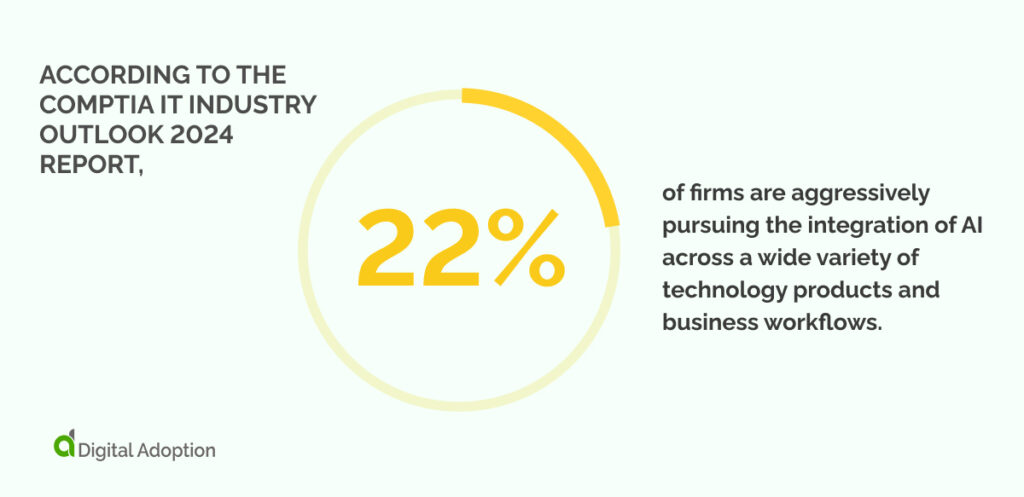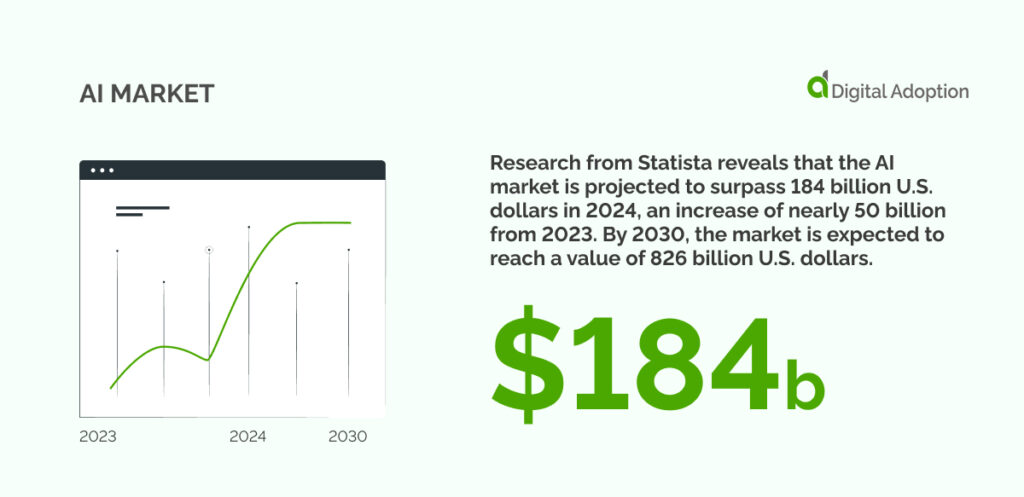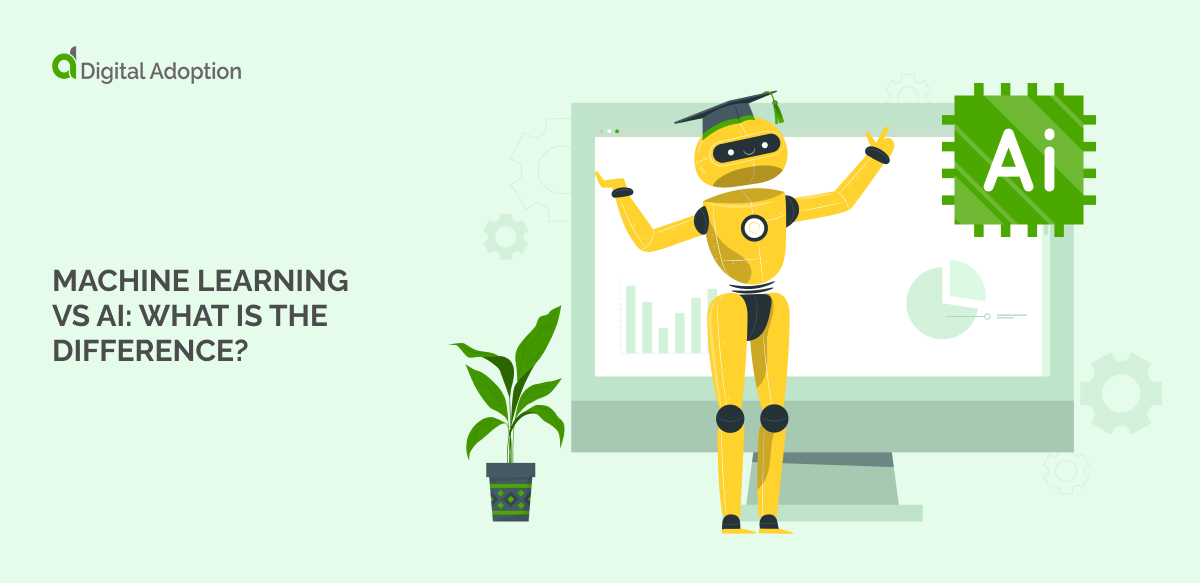Artificial intelligence (AI) and machine learning (ML) are often used interchangeably. However, these disciplines each have unique distinctions within the realm of advanced computing.
AI is a broad discipline focused on developing systems capable of performing tasks to a similar level to human intelligence. ML is a dedicated subset of AI. It specializes in creating algorithms capable of making predictions or decisions by learning from big data.
The diverse array of pain points across industries requires equally diverse solutions. In the medical field, rule-based AI is well-suited for making explicit classifications. These systems are designed to address specific, logic-based problems.
Alternatively, machine learning (ML) is driven by data. The broad scope of its development allows these systems to self-iterate and improve performance as more data is fed into them.
In this article, we’ll define machine learning and AI before delving into their differences. We’ll also reveal how these technologies intertwine and work best when in tandem.
What is machine learning?
Machine learning (ML) involves training computer systems to simulate intelligent actions from data they learn. ML algorithms analyze and organize input data to generate targeted outputs.
ML is an AI technology capable of completing tasks and self-improvement without preprogrammed instructions. Its top application areas include pattern recognition, statistical forecasting, and advanced decision-making.
What is AI?
Artificial intelligence (AI) teaches computers to simulate highly intelligent actions without explicit pre-programming. Advances in AI result from decades of research and development in data science.
AI’s development is driven by innovations in machine learning algorithms, neural networks, and natural language processing techniques. It serves as the umbrella term encompassing various dedicated lines of research and development.

Narrow AI represents the systems we commonly encounter today. This type of AI is specialized for specific tasks and operates within predefined parameters. In contrast, General AI aims to replicate human cognitive abilities across various tasks. For now, this remains an aspirational goal on the horizon.
What is the difference between machine learning and AI?
ML is a subset of AI that teaches algorithms to learn patterns, generate predictions, and execute decisions based on input data.
The more data a model learns from, the better its performance. This learning process shows machine learning’s unique ability to navigate complex computational environments. ML development is embedded with AI principles. This relationship means ML contributes to AI’s broader goal of creating intelligent systems.
AI encompasses the broader field, of which ML is a part. Developments in AI are wide in scope. It encompasses various systems that follow different lines of operation. Some AIs are rule-based, making decisions only along predefined parameters.
Other AI, such as search algorithms, follow heuristic methods to find optimal solutions. This can include pathfinding in navigation systems or game-playing strategies.
All ML involves AI, but not all AI involves ML. The key differences lie in their programming, adaptability, and use cases. AI technologies can each target different pain points. Specifying problems that require the most attention is key to choosing the right solution.
Let’s break this down in the chart below to better understand their distinctions.
| Key Specifications | Artificial Intelligence (AI) | Machine Learning (ML) |
| Approach | Utilizes various approaches, including rule-based systems, heuristic search, and deep learning to simulate human intelligence | Focuses specifically on algorithms that learn from data and make predictions or decisions |
| Programming | Involves diverse programming paradigms such as logic-based programming, symbolic reasoning, and knowledge representation | Centers around algorithmic development, including supervised learning, unsupervised learning, and reinforcement learning techniques |
| Adaptability | Capable of generalizing knowledge across different domains and tasks, enabling flexible problem-solving and decision-making capabilities | Adapts performance based on training data and ongoing iterations, improving accuracy and efficiency over time |
| Use-cases | Applied in autonomous systems, natural language processing, robotics, and expert systems for complex decision-making | Commonly used for predictive analytics, anomaly detection, and recommendation systems. Text analysis and sentiment analysis (social media monitoring, customer reviews) |
| Complexity handling | Manages complex reasoning tasks, understanding unstructured data, and real-time decision-making in dynamic environments | Handles large-scale data processing, pattern recognition, and optimization tasks, automating insights extraction from big data |
| Examples | IBM Watson for healthcare diagnostics, autonomous vehicles, virtual assistants like Siri and Alexa | Fraud detection algorithms, personalized recommendation engines, facial recognition systems like those used in security applications |
| Future potential | Continues to evolve towards achieving General AI capabilities, aiming for human-like reasoning and learning across diverse applications | Advances in deep learning and neural networks drive innovation in areas such as healthcare diagnostics, autonomous navigation, and personalized services. |
| Business impact | Transforms industries through automation, efficiency gains, enhanced decision-making, and personalized customer experiences. | Drives data-driven insights for operational efficiencies, customer segmentation, targeted marketing, and predictive maintenance in manufacturing and finance sectors |
Examples of how machine learning and AI work together
AI technologies are inherent in ML. This naturally ensures they remain intertwined despite their distinct offerings.
ML is rooted in data. It drives iterative improvements and ongoing exploration for reliable outcomes. AI, in contrast, extends into specialized tasks. These can include automating complex decisions, understanding different accents, and simulating intelligent functions.
Below, we explore a few examples of how machine learning and AI work well together. These examples include various industry use cases that demonstrate the diverse power of AI and ML when combined.
Powering AI with learning
When machine learning (ML) and artificial intelligence (AI) converge, they amplify the learning process in blockchain security.
AI enhances ML’s adaptability by adjusting models based on real-time data inputs. This ensures quick response times to threats. This helps to deepen analytical insights. AI’s proficiency in processing unstructured data complements ML’s structured approach. This reveals nuanced patterns that are key to identifying unforeseen risks in blockchain transactions.
AI also augments ML’s predictive capabilities. These enable organizations to anticipate security threats before they manifest. Driven by AI-driven feedback loops, it ensures that blockchain security measures develop effectively. Ultimately, AI and ML support scalability, efficiency, and operational resilience in safeguarding decentralized environments.
Extracting insights from data
AI-driven analytics can track and evaluate user interactions and performance metrics in real-time. For instance, AI algorithms can measure how quickly users respond to challenges. They can even measure how accurately they complete tasks within virtual environments.
Meanwhile, ML analyzes intricate patterns in user behavior. These can include navigation preferences and decision-making processes during simulated scenarios.
These detailed insights enable training programs to adjust difficulty levels and content presentation. For example, AI can identify users encountering difficulty with a specific task. Machine learning then tailors subsequent scenarios. They offer additional guidance or challenges to improve proficiency in that area.
This enables higher-quality learning and ensures efficient use of training resources. It does this by focusing on areas where learners can benefit the most. VR training platforms can anticipate future learning needs and adapt content by identifying trends in user performance. This enhances the effectiveness of VR training by creating an adaptive learning environment.
Refining and adapting AI systems
The evolution of data analytics is transforming how manufacturers approach equipment maintenance. Powerful analytics tools are now deployed to process vast quantities of equipment performance data.
This data encompasses both historical trends and real-time sensor readings. It provides a comprehensive picture of equipment health. This in-depth analysis empowers manufacturers to identify issues before they escalate. Advanced algorithms are continuously refined to predict maintenance needs with even greater accuracy.
This shift from reactive to preventive repairs reduces downtime and maximizes operational efficiency. As a result, manufacturers experience many benefits. These include increased output, reduced maintenance costs, and a more reliable production environment.
Tackling complex problems
Advanced data analysis is shaking up financial decision-making. Using sophisticated algorithms, financial institutions can process and analyze massive datasets. These can encompass historical market trends, real-time market movements, and economic indicators.
This analysis allows for generating highly accurate forecasts on market behavior and evaluating potential investment risks. Moreover, these analytical capabilities are constantly improving.
Machine learning constantly refines predictive models used for financial analysis. This ongoing refinement empowers financial professionals with ever-more precise forecasts and strategic insights. As a result, financial institutions are better equipped to navigate the complexities of the market and make well-informed investment decisions.
Enhancing automation
The manufacturing sector is experiencing a significant transformation driven by advancements in artificial intelligence (AI). AI automates various processes by optimizing robotic processes for enhanced efficiency and precision. Machine learning (ML) algorithms play a crucial role in this transformation. They analyze vast amounts of production data to identify areas for improvement. This streamlines workflows and allows for more rigorous quality control procedures.
The integration of AI-driven robotics extends beyond basic automation. These intelligent systems tackle complex tasks like assembly and packaging with remarkable accuracy. This translates to a significant reduction in cycle times, the time it takes to produce a single unit.
The net result is a substantial boost in overall operational productivity within modern manufacturing facilities. AI is revolutionizing manufacturing by driving efficiency, quality, and increased output.
Personalization and recommendation
Advanced data analytics are transforming customer interactions in digital marketing. Marketers can use vast datasets to better understand consumer behavior and preferences. This enables the creation of targeted campaigns tailored to individual interests and purchasing patterns.
Sophisticated segmentation tools power this approach. They ensure messages resonate with the most relevant customer groups. Intelligent recommendation engines personalize product offerings and content. They encourage deeper customer engagement and drive significant conversion rates across e-commerce platforms.
The power of data analytics in digital marketing is constantly evolving. Marketers can leverage even more sophisticated tools and techniques as technology advances and consumer behavior shifts.
This ongoing development allows for a more dynamic and responsive approach to customer interactions. It ultimately leads to a more effective digital marketing experience for all parties involved.
What does Machine learning vs AI look like going forward?
Artificial intelligence (AI) has advanced dramatically over the decades. It has progressed from far-flung sci-fi concepts to practical applications today. AI is currently impacting many sectors, such as retail, finance, and entertainment.

AI’s future promises further advancements. These advancements include enhancing personalized customer experiences. AI will also optimize business operations via predictive analytics and develop autonomous systems for improved efficiency and safety. However, it’s also essential to address material risks around data privacy, bias, and responsible AI use.
Despite this, AI’s journey is one of ongoing optimistic research and technological innovation. Embracing its potential while managing its challenges will determine how AI transforms wider society in the years ahead.









